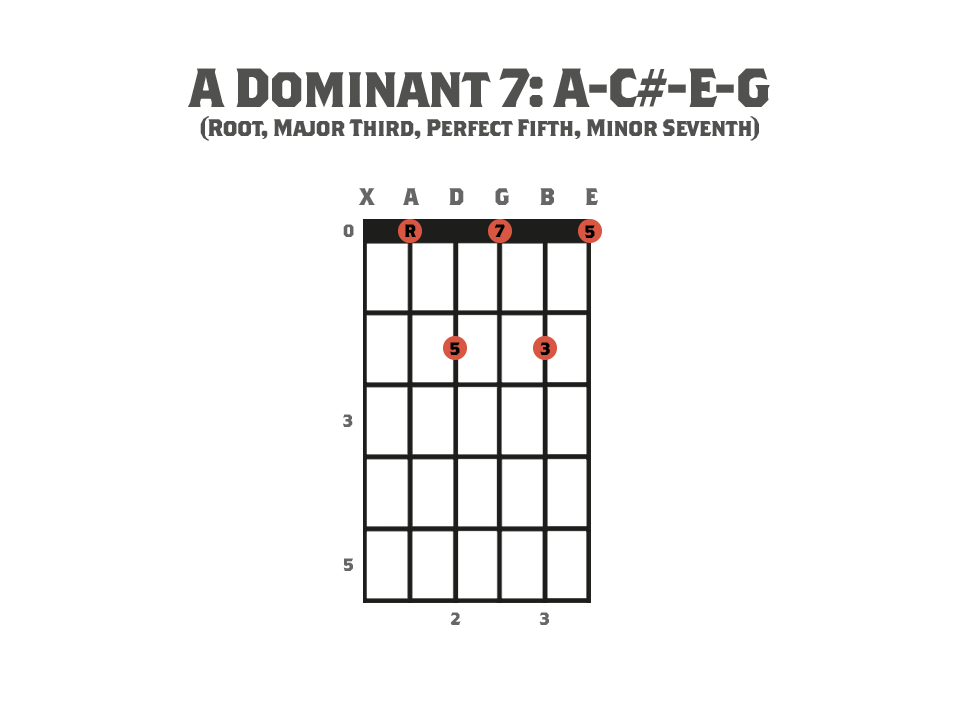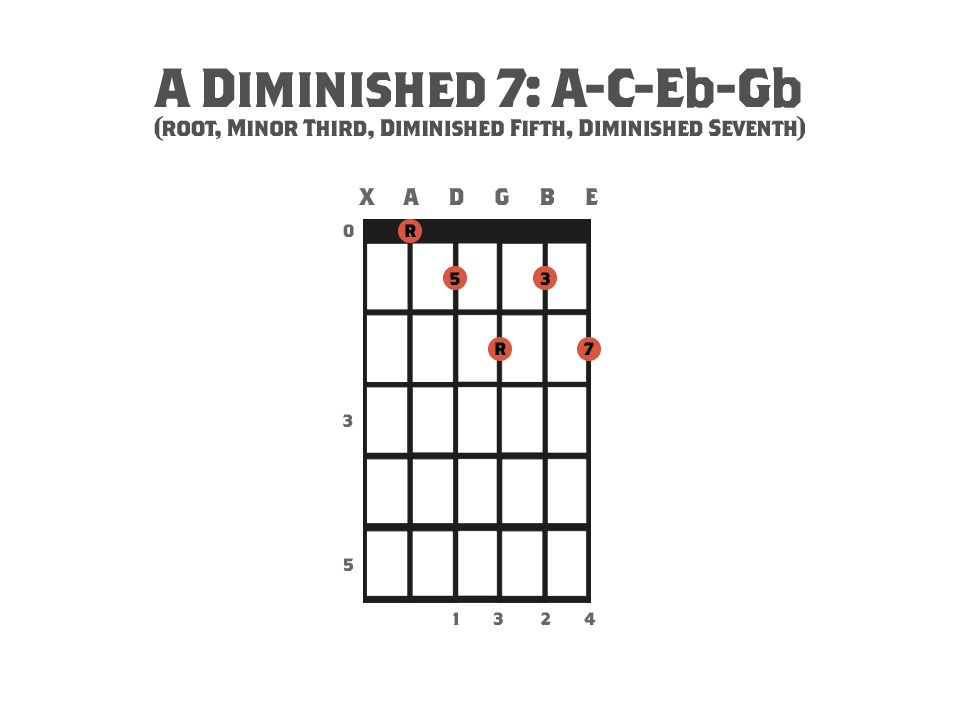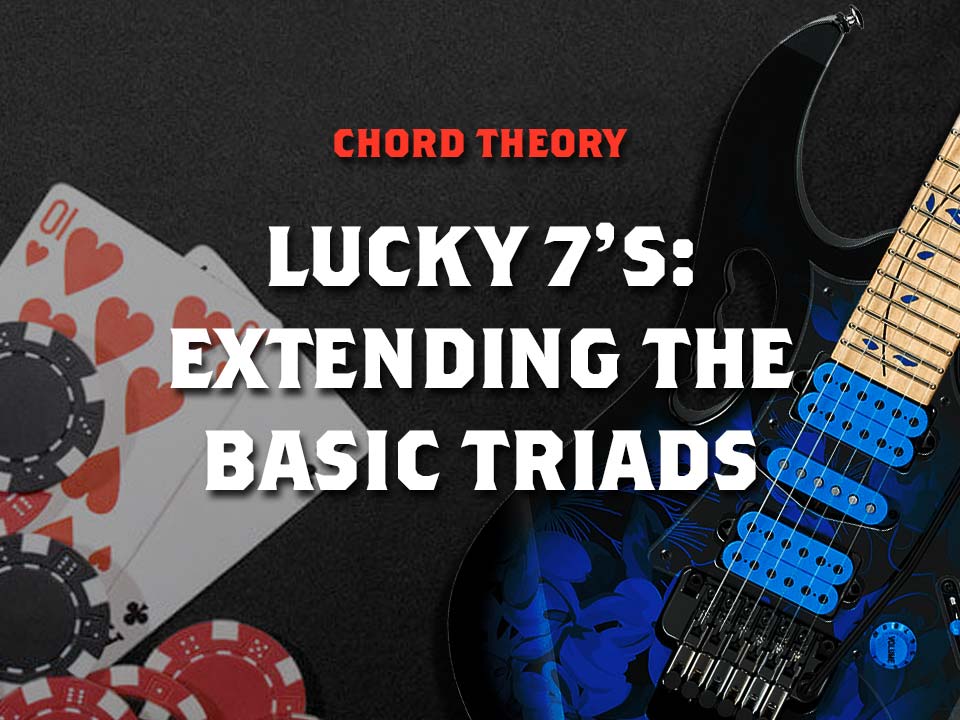Today we’re going to look at extending the basic chord triads by adding a 7th. This will give us a whole new set of ‘Seventh Chords’.
If you’re not sure how to form the basic triads check out our post on doing exactly that, here. You may also want to check out our post on intervals if you’re not sure of the difference between a minor 7 and a major 7, however the diagrams below should make things fairly clear.
There are a number of different ways we can add sevenths to chords, I’ve listed 6 of the most common below. The first 4 are the most common and all occur in the Major scale.

Basically we’re going to take the four main triads, minor, major, diminished and augmented, and then add the seventh note of a corresponding scale or mode in order to create a ‘seventh chord’. For example the seventh note of the A minor scale is ‘G’ so we can add this to an Am triad to get Am7 (A-C-E-G).
Using the same root note I’ll show how each of the above chords are formed. In this example we’ll use ‘A’.
Seventh Chords – A Major 7
Let’s start with AMaj7. The notes are:
A – C# – E – G#
So we have an A Major triad (A-C#-E) plus the note ‘G#’ which is a Major seven interval above the root note (A). If you look at the A Major scale, or A Ionian mode, you’ll see that A is the first note, C# is the third, E is the fifth and G# is the seventh.
Major seven chords occur on the first and fourth degree’s of the Major scale. Below is a diagram of how to fret A Major seven in an open position:

I have marked the Root, Major 3rd, Perfect 5th and Major 7th. The numbers underneath are a suggestion of which fingers to use.
Most chords can be played in a variety of different ways on the guitar, the above diagram should get you started with A Major seven. This can be converted to a bar chord and moved up the fretboard to get A# Major 7, B Major 7 and so on.
A minor 7
The minor 7 chord occurs 3 times within the Major scale, making it the most common seventh chord type within the scale (The Major 7 occurs twice as the I and IV chords and Dominant 7 and minor 7 flat 5 both occur only once as the V chord and VII chord respectively). Minor 7 occurs as the II, III and VI chord. Therefore the notes of Am7 will occur in the A Dorian mode, the A Phrygian mode and the A Aeolian mode.
Below is a diagram showing an open position voicing for Am7:

A minor 7 differs from the Major 7 chord due to the m3 and m7, the root and 5th are the same.
Remember that this chord voicing can be played as a barre chord. Use your index finger to ‘bar’ across the strings. This means you can move it up the neck to get Bbm7, Bm7, Cm7 and so on.
A Dominant 7
A7 or A Dominant 7 would be the V chord in the key of D Major. It is an A Major triad like the Major 7 but with a m7 instead of a Maj7 interval. Used in all genres of music Dominant chords can also be useful for changing key.

Dominant 7th chords are used frequently to resolve back to a I chord. This chord pulls toward an ending for song or section of music.
A minor 7 flat 5
Half Diminished or “m7b5” chords occur as the VII chord within the Major scale. Minor 7 Flat 5 is formed using a diminished triad with an additional m7 interval. So Am7b5 would contain the notes A, C, Eb and G.

Minor 7 Flat 5 is often used as a passing chord due to its dissonant sound and can also be used to create tension.
A minor (Major 7)
Am(Maj7) is the I chord from the A Harmonic Minor scale. This scale is like the Natural minor (Which gives us a m7 chord) but with a raised 7th note. A Harmonic minor would contain the notes:
A – B – C – D – E – F – G# – A
This means that we still get an A minor triad but with a Major 7:

You might have noticed that without the note A the remaining notes give us a C+ chord (C Augmented). Because of this the Am(Maj7) chord has a similar quality to an Augmented triad but less pronounced. Useful for creating a tense or mysterious sound.
Seventh Chords – A Diminished 7
The last chord we’re going to look at in this post is the Diminished 7. Many people confuse this with the m7b5. This chord is formed using a diminished triad with a diminished 7 interval instead of a minor 7 interval.
This is another great chord for creating tension and is great for sweeping arpeggios too!

A diminished 7 interval is the same as a Major 6 interval. A Major 6 in relation to A would be the note F#, however in the context of a diminished 7 we name the note Gb.
ADim7 occurs as the VII chord in Bb Harmonic minor, the notes of the scale are:
Bb – C – Db – Eb – F – Gb – A – Bb
So you can see that the notes A, C, Eb and Gb are all present within this scale.
In the second part of this post we’ll look at some less common types of seventh chord.
Footnote: The guitar featured in the cover image of this post is the ‘Jem 77P’ made by Ibanez Guitars for Steve Vai as a part of his signature guitars.


Join The Strings of Rage Syndicate!
Take your guitar playing to the next level. Join the community for exclusive new lessons, ideas and over the top guitar creativity! We look forward to seeing you around!











5 Comments
[…] If you aren’t sure how to create 7th chords check out our post here. […]
[…] and altered in order to create more chords such a Major7, minor7 and various others. Check out this post for more info on 7th […]
[…] out this post for more on 7th chords. The next step is to break down the lick, I’ll look at each bar […]
[…] 7th Chords and beyond however, start to sound ‘muddy’ and unclear like this: […]
[…] this post for more on 7th […]